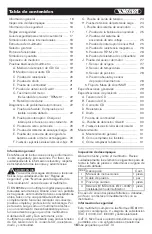
Automotive Servicing Safety Guide
3
figure 1
All the information, explanations and detailed
descriptions in the operation manual have originated
from the industrial information recently published.
It is impossible to prove the accuracy and
completeness of the information, of which we shall
not be responsible for the assumption.
A. The data of the automotive servicing manual
have originated from the automotive servicing
information.
1. Contact the local distributors of automotive
components.
2. Contact the local retailers of automotive
components.
3. Contact the local libraries to look up any book
for the proofreading of your automotive servicing
manual so as to provide you with the latest
information.
B. Before the diagnosis of any trouble, open the
engine hood to make a thorough visual
inspection. You will find the causes for many of
your problems to be solved, which will save you
a lot of time.
1. Has the automobile recently been serviced? Has
the same problem sometimes occurred where
the trouble lies?
2. Do not try to find any short cut. Check the
hoses and leads where it is probably very
difficult to find out where any trouble lies.
3. Check any trouble with the air purifier or pipeline
system.
4. Check any damage to any sensor or the driving
gear.
5. Check the ignition lead: any breakage of any
terminal, crack on any spark plug or breakage
at the insulation of the ignition lead.
6. Check all the vacuum hoses: any right line,
shrinkage, bend, crack, fracture or damage.
7. Check the leads: any connection of sharp
edges, connection of hot surfaces (such as
exhaust manifold), shrinkage, burn or scratch
at the insulation or right line connection.
8. Check circuit connections: any pin corrosion,
bend or damage, inappropriate connection
position or damaged electrode lead.
AC (Alternating Current).
Grounding.
Double Insulated.
Deficiency of Built-In Battery.
Fuse.
Warning. Refer to the Operating
Manual.
Conforms to Standards
of European Union.
International Electrical Symbols
The Multimeter Structure
(see figure 1)
Rotary Switch
1. LCD display
2. Data Hold button
3. Rotary Switch
4. Input Terminals
5. Power button
Below table indicated for information about
the rotary switch positions.
Rotary Switch
Position
Function
V
DWELL
RPM x 10
V
A
DC voltage measurement.
AC voltage measurement.
DC Current Measurement
Diode test.
Continuity test.
Resistance measurement.
Automotive ignition dwell testing,
Unit: degree
Automotive engine tach (rotation
speed) testing (Displayed
Reading x 10), Unit: rpm
Ω
Functional Buttons
Below table indicated for information about
the functional button operations.
AC
voltage measurement.
HOLD
Turn the power on and off.
•
Press HOLD once to enter hold mode.
•
Press HOLD again to exit hold mode
and the present value is shown.
• In
Hold mode, is displayed
Display Symbols
(see figure 2)
figure 2
Summary of Contents for KN 8056
Page 1: ...KN 8056 Digital automotive multimeter Mult metro digital automotriz...
Page 33: ...Notes Notas...
Page 34: ...www knova com mx...





































